|
This brief passage just about sums up my
thoughts on coinage in relation to portraiture before I took this class.
I had never thought of coins as having anything but economic, monetary
value, and if there was any artistic value in money it would have to
be in paper money, which (with the glaring exception of our own country)
sports a multitude of beautiful designs from all across the globe. There
is, however, one problem with paper money – the bills in my wallet are
worn out enough having been around only a few years – as a historical
document, paper money is not the best option. Furthermore, paper money
is more of a recent development, so the history it could give us is
a somewhat recent one at that. Coinage, on the other hand, serves as
a splendid document of history, not only dating back to ancient times
but also being crafted out of materials that could withstand the passage
of that time. Indeed, unlike tools or weapons, which many times have
symbols on them or don’t have enough room for more detailed drawings,
coins provide a fantastic framework on which not only symbols but more
involved drawings can be made…like portraits, for example! Coins provide
wonderful insight into many aspects of history, the most obvious being
economic history but also political and, to our luck, art history.
The first coins were made out of a material
called electrum, an alloy of gold, silver, and traces of other metals
that occurs naturally. Dating from before the 6th century
BC, these first coins were few and far between and contained mostly
symbols rather than the future ubiquitous portraits. These early coins
are fascinating, not only for the surprising amount of detail contained
in the drawings of the symbols but the somewhat irregular shape of the
coins as well – it seems they hadn’t yet perfected the circular shape!
The portrait coins are what interests us, though, and one of the earliest
I could find a picture of came out of Athens, one of the most important
early coin producers. It dates from the 6th century BC, and
bears the head of Athena on one side and an owl on the reverse with
the name of the city. The owl is significant because it is Athena’s
sacred bird. These early Greek city-states were very proud, independent
entities and symbols like the owl were their way of differentiating
coins of one city-state from another. Also noteworthy of this time is
the usage of a god/goddess rather than the actual ruler of the city-state
as the portrait on the coin. This can perhaps be at least somewhat attributed
to the artistic style of the time, which was still in the idealistic/stylized
phase – what could be more perfect than the head of a great god or goddess
gracing your city-state’s coinage?
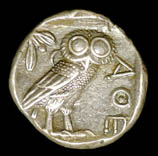
5th Century B.C. |
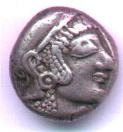
Athena |
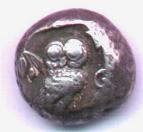
Reverse side |
The portrait of Athena is very
much indicative of the time period in which it was made – not too
idealistic, with hardly any detail on her face. Her headdress/helmet,
though, does exhibit a good deal of detail, although much of it is
obscured by the reflection in the lighting. Her eyes and lips seem
to be somewhat exaggerated, somewhat bigger than in real life, giving
her an overall impression like that of a cartoon character. The shape
of the coin is also somewhat irregular. This particular coin offered
me a great opportunity to see how the same coin design evolved over
time; another reference has the same coin as the first, but from three
different, successive time periods. The earliest, from 495 to 480
BC, has much of the same qualities as the previous one I just described.
The second coin, dated from 449 to 413 BC, shows markedly more detail
in its engravings although being only 50-75 years younger than the
previous. Part of this may be attributed to the superior condition
of the second coin, but I thought I could notice more detail and realism
in general. The facial features are not so exaggerated, the helmet
is more finely detailed and the owl is infinitely easier to recognize
than in the older coin. Even the owl’s individual feathers around
his head are noticeable, an amazing achievement while still remembering
this is from about 2500 years ago. The third coin, dating from 160
to 157 BC, represents a quantum leap over the other in terms of both
realism and detail, reflecting the Hellenistic artistic style of the
time. The features of Athena are very lifelike and proportionally
closer to real life. One can almost detect a hint of expression in
her face, even if that expression is a serious one. Her helmet is
exquisitely detailed with clearly recognizable olive leaves and detailed
hair. Even the owl has more detail, with many more Greek letters engraved
around it still readable.
(1 coin)
(2 coins)
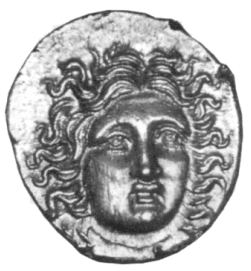
Helios, or Apollo |
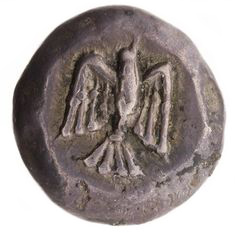
Siphnos, 540 BC - 525 BC |
Let us try and trace the same evolution with
a different set of coins. The first weblink {no longer online; see
alternate image, Helios, above} is to another one if the oldest
coins I could find a picture of. This particular coin was struck in
Siphnos, another Greek city, around the fifth century BC, and bears
the head of Apollo on one side and an eagle on the other. Apollo is
another famous Greek god, perhaps again reflecting the stylized, somewhat
idealistic style of the Archaic period, although this practice was continued
in subsequent years as well. The coin itself is somewhat irregularly
shaped, another sign of its age. Apollo’s features, much like the first
coin of Athena we looked at earlier, are somewhat exaggerated, with
little detail, especially in the facial area. His eyebrow is very thick,
his eye is huge, his lips almost swollen. The other side of the coin
has an eagle in flight, with some detail given to the feathers and wings
– note the differentiation between the feather of the eagle’s body and
wings - but still not much overall. Part of this can be attributed to
the coin’s wearing away with time, but for the most part we can conclude
that there is minimal detail and realism portrayed in this early coin.
The second weblink {no longer online; see
alternate image, Athena, below}contains the next two coins – the
first hails from about 425 to 400 BC and is from a slightly different
area than the others – Lucania, in Italy. However, Greek influences
abound, as one side of the coin holds a portrait of Athena. Athena’s
features are more realistic than Apollo’s in the previous coin, with
less exaggeration of features and very close to the correct proportions,
it seems. There is more detail in her helmet – one can make out olive
branch on the helmet very clearly – and overall much more realism.
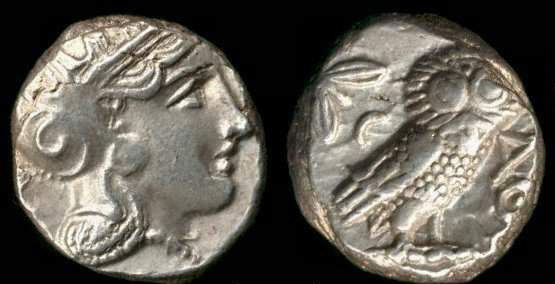
Athena with the Attic
helmet decorated with olive tree; owl with an olive branch
Even the bull on the other side is somewhat realistic;
although the fish is hard to see, one can easily make out the Greek
letters, a display of amazing detail. Another coin was struck around
281 to 272 BC {see alternate image, below}, and comes from Calabria,
also in Italy. This coin demonstrates another important aspect of Hellenistic
art – that of movement. One side of the coin shows Taras, the founder
of the city, riding a dolphin with a bow and arrow in his hands. He
is not posing; this is a portrait of a man in motion, and while it is
somewhat hard to see, one can make out extremely delicate work in crafting
the detail of the bodies in motion. The reverse side shows a boy son
a horse being crowned by another man – a reference to horse racing.
Even here, although the coin is somewhat more worn away, the detail
is admirable and the sense of motion readily apparent.
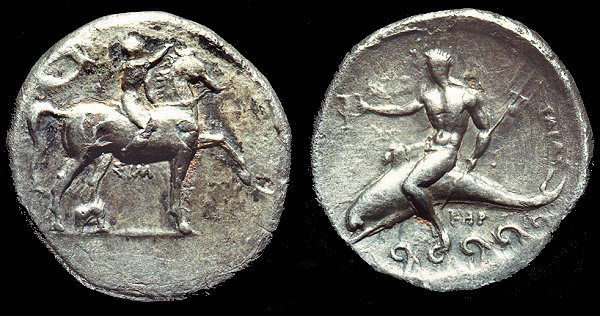
302-281 BC; Taras carries
cup & trident
The evolution in the above coins is a definite
one: The stylized, somewhat more simple style of the Archaic period
in which the very first coins were struck gives way to the somewhat
more detailed, yet still idealistic style of the Classical period in
which coin production began to flourish which in turn progresses even
further to the extremely detailed, lifelike, often motion-filled renderings
of the Hellenistic period in which one can almost begin to detect a
hint of expression in the characters’ faces. I hope that my admittedly
elementary analysis of the coins did not come across as judgmental –
the stylized early coins have just as much artistic value as the later,
detailed ones and I admire the craftsmanship in both highly. My only
intention was to demonstrate that the evolution of styles we discussed
in class could be seen quite wonderfully in the coinage of the times.
References
Jentoft-Nilsen, Marit. Ancient Portraiture:
The Sculptor’s Art in Coins and Marble. Richmond: Virginia Museum,
1980.
Starr, Chester G. Athenian Coinage 480-449 B.C. London: Oxford
University Press, 1970.
Gardner, Percy. A History of Ancient Coinage: 700-300 B.C. Chicago:
Ares Publishers, 1918.
Carradice, Ian. Greek Coins. Austin:
University of Texas Press, 1995.
http://www.usask.ca/antiquities/coins
http://www.gla.ac.uk/hunterian
|